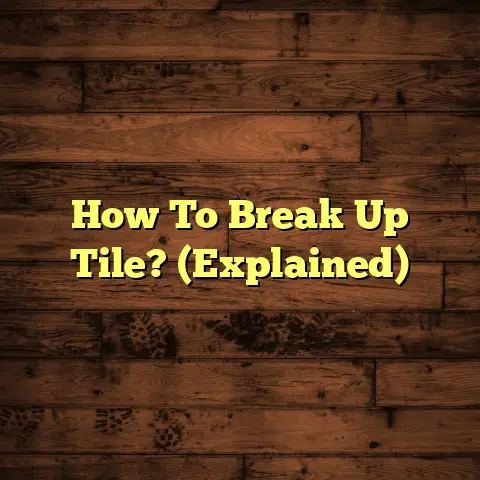Water Damage on Wood Floors? (3 Hour Window!)
Not the good kind, like sinking into a comfy couch, but the kind where you see a mini-lake forming on your beautiful wood floors?
Yeah, water damage. It’s a flooring contractor’s nightmare and a homeowner’s worst fear.
But don’t panic! You’ve got a fighting chance, especially if you act fast.
I’m talking about a 3-hour window – a critical period where you can minimize the damage and potentially save your floors.
In this article, I will share my experience and guide you through everything you need to know about water damage on wood floors.
We’ll cover the science, the immediate steps, the assessment, and even some long-term prevention tips.
Let’s dive in, shall we?
1. Understanding Water Damage on Wood Floors
1.1 The Nature of Wood as a Material
Wood is a fantastic material. It’s warm, beautiful, and adds character to any home.
But here’s the thing: wood is like a sponge. I’ve seen it firsthand, folks.
It’s porous, meaning it has tiny little holes that can soak up moisture like crazy.
Think of it this way: when wood gets wet, it expands. When it dries, it shrinks.
Now, not all wood is created equal. Oak, for example, is a pretty durable hardwood.
Maple is another popular choice, known for its smooth grain. Cherry is beautiful but can be a bit more sensitive.
Each type reacts differently to water exposure. Denser woods tend to be more resistant, but even they have their limits.
1.2 Common Causes of Water Damage
Where does this water damage come from, anyway? I’ve seen it all in my years.
-
Flooding: Obvious, right? But even a few inches of floodwater can wreak havoc.
-
Leaks: From leaky pipes under the sink to a dripping roof, leaks are silent killers.
-
Humidity: High humidity can cause wood to absorb moisture from the air.
-
Spills: That spilled glass of water might seem harmless, but it can seep into the cracks between boards.
Let me tell you about Mrs. Johnson. She had a slow leak under her kitchen sink for months.
She didn’t notice it until the floor started to buckle. By then, the damage was extensive, and the repair bill was hefty.
Don’t be like Mrs. Johnson! Be vigilant.
1.3 The Immediate Effects of Water Exposure on Wood Floors
Okay, so water meets wood. What happens next? First, the wood starts to absorb the water.
The boards swell, and you might notice them starting to cup or buckle.
Cupping is when the edges of the boards rise higher than the center.
Buckling is when the boards actually lift off the subfloor.
Aesthetically, you’ll see discoloration. The wood might turn darker or develop water stains.
Structurally, the wood becomes weaker and more susceptible to mold and rot.
I’ve seen floors where you could literally push your finger through the rotten wood. Not good.
2. The 3-Hour Window for Action
2.1 The Critical Importance of Time
Why 3 hours? Because that’s generally the window of opportunity to minimize the damage.
After 3 hours, the water starts to penetrate deeper into the wood and the subfloor.
The longer the water sits, the harder it is to remove and the more likely you are to have long-term problems like mold.
According to the Institute of Inspection Cleaning and Restoration Certification (IICRC), mold can start to grow within 24-48 hours of water damage.
That’s why speed is of the essence.
2.2 Step-by-Step Guide for Immediate Response
Alright, the clock is ticking! Here’s what you need to do:
-
Stop the Source: First and foremost, stop the water flow. Turn off the main water valve if necessary.
-
Remove Standing Water: Use towels, mops, and a wet/dry vacuum to remove as much standing water as possible.
-
Dry the Area: Open windows and doors to increase air circulation. Use fans to blow air across the floor.
-
Assess the Damage: Take a quick look at the extent of the damage. Is it localized, or is it widespread?
-
Document Everything: Take photos and videos of the damage for insurance purposes.
2.3 Tools and Equipment Needed for Emergency Response
Having the right tools on hand can make a huge difference. Here’s what I recommend:
-
Wet/Dry Vacuum: Essential for removing standing water.
-
Fans: To circulate air and speed up the drying process.
-
Dehumidifier: To remove moisture from the air.
-
Moisture Meter: To measure the moisture content of the wood.
-
Towels and Mops: For soaking up water.
-
Gloves and Protective Gear: To protect yourself from contaminants.
Using a moisture meter is simple. Just press the probes into the wood and read the percentage.
A normal moisture content for wood floors is between 6% and 8%. Anything above that is cause for concern.
3. Assessing the Damage
3.1 Visual Inspection Techniques
Okay, you’ve stopped the bleeding, so to speak. Now, let’s take a closer look.
-
Warping: Are the boards bending or twisting?
-
Buckling: Are the boards lifting off the subfloor?
-
Discoloration: Are there water stains or changes in color?
-
Swelling: Are the boards thicker than usual?
-
Cracking: Are there cracks in the wood?
Pay close attention to the edges of the boards and the areas near walls and doorways.
These are often the first places to show signs of damage.
3.2 Using Moisture Meters
Moisture meters are your best friend when it comes to assessing water damage.
They tell you exactly how much moisture is in the wood.
There are two main types of moisture meters: pin meters and pinless meters.
Pin meters have two small pins that you insert into the wood. Pinless meters use electromagnetic waves to measure moisture.
I prefer pinless meters because they don’t leave holes in the wood.
To use a moisture meter, simply turn it on and press it against the floor.
Take readings in several different areas, including areas that look dry and areas that look wet.
Compare the readings to the normal moisture content for wood floors (6%-8%).
3.3 Documenting the Damage for Insurance Claims
Insurance companies can be tricky, so documentation is key.
-
Take Photos: Lots of them! Capture the overall damage and close-ups of specific areas.
-
Take Videos: Walk through the affected areas and narrate what you see.
-
Write Detailed Descriptions: Note the date and time of the damage, the source of the water, and the extent of the damage.
-
Keep Receipts: Save all receipts for any supplies or services you purchase.
-
Contact Your Insurance Company: As soon as possible, file a claim and provide them with all your documentation.
Remember, the more evidence you have, the better your chances of getting a fair settlement.
4. Immediate Repair Techniques
4.1 Drying Out the Area
Drying is the name of the game. The faster you dry the floor, the better.
-
Air Circulation: Open windows and doors to create a cross breeze.
-
Fans: Position fans to blow air across the floor.
-
Dehumidifiers: Run dehumidifiers to remove moisture from the air.
-
Remove Baseboards: Removing baseboards allows air to circulate behind them and helps dry the walls.
I once worked on a house where the homeowner tried to dry the floor with a space heater. Big mistake!
The heat caused the wood to dry too quickly, leading to cracking and warping.
Slow and steady wins the race.
4.2 Temporary Fixes for Minor Damage
Sometimes, you can get away with temporary fixes while you wait for professional help.
-
Warped Boards: Place heavy objects on top of warped boards to try to flatten them.
-
Swollen Boards: Use a dehumidifier to slowly dry the boards and reduce swelling.
-
Loose Boards: Apply construction adhesive to loose boards and weigh them down until the adhesive dries.
These are just temporary solutions, though. They won’t fix the underlying problem.
4.3 When to Call Professionals
There are times when DIY just isn’t enough. Call a professional if:
-
The Damage is Extensive: If a large area is affected, it’s best to call in the pros.
-
You Suspect Mold: Mold can be dangerous and requires professional remediation.
-
The Floor is Buckling: Buckling indicates serious structural damage.
-
You’re Unsure What to Do: If you’re feeling overwhelmed, don’t hesitate to call for help.
A water damage restoration service will have the expertise and equipment to properly dry and repair your floors.
They can also help you navigate the insurance claims process.
5. Long-Term Effects of Water Damage on Wood Floors
5.1 Potential Structural Issues
Untreated water damage can lead to serious structural problems.
-
Mold Growth: Mold can grow quickly in damp environments and can cause health problems.
-
Rot: Wood rot weakens the floor and can eventually cause it to collapse.
-
Subfloor Damage: Water can damage the subfloor, which can lead to uneven floors and structural instability.
I’ve seen cases where homeowners ignored water damage for too long, and the entire floor had to be replaced.
Don’t let that happen to you!
5.2 Financial Implications
Ignoring water damage can be costly.
-
Repair Costs: Repairing water-damaged floors can range from a few hundred dollars to several thousand dollars.
-
Replacement Costs: Replacing an entire floor can cost even more.
-
Health Costs: Mold-related health problems can lead to doctor visits and medication costs.
According to HomeAdvisor, the average cost to repair water damage is around \$3,000.
Prevention is always cheaper than cure.
5.3 Preventative Measures for the Future
Here are some things you can do to protect your wood floors from future water damage:
-
Regular Inspections: Check for leaks around pipes, sinks, and appliances.
-
Maintain Plumbing: Fix leaky faucets and pipes promptly.
-
Proper Ventilation: Ensure proper ventilation in bathrooms and kitchens.
-
Use Rugs and Mats: Place rugs and mats in high-traffic areas and near water sources.
-
Monitor Humidity Levels: Use a dehumidifier to control humidity levels in your home.
I always tell my clients to be proactive. A little prevention can go a long way.
Conclusion: The Urgency of Addressing Water Damage
Water damage on wood floors is a serious issue, but it’s not the end of the world.
By acting quickly and following the steps outlined in this article, you can minimize the damage and potentially save your floors.
Remember, the first 3 hours are critical. Don’t delay!
And don’t forget to take preventative measures to protect your floors from future water damage.
Your floors will thank you for it!





